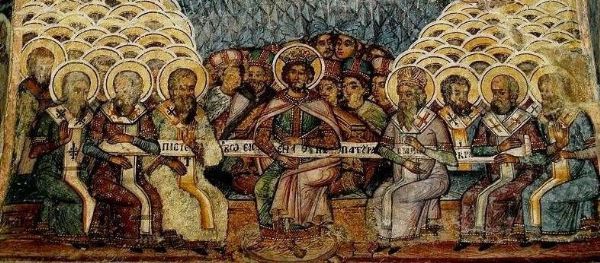Our Creed
Our Creed

A creed is a statement of faith. The word comes from the Latin word credo, which means “I believe”.
There are a number of local creeds that have been used in various parts of the Church at different times to express certain aspects of the Faith of the Church. However, there is only one that is universal, and its full name is the Nicene-Constantinopolitan Creed. If this sounds like a bit of a mouthful, that’s because it is.
It has this name because it is the result of prayer, debate, and discussion about the earliest teachings of the Church, which took place at the first two Ecumenical Councils in Nicaea (325) and Constantinople (381), respectively. Most often, we just call it The Creed or sometimes The Symbol of Faith. You can learn more about the role of Ecumenical Councils on the “Holy Tradition” pages of this section of our website.
At these councils, many bishops and others, some of whom are now recognised as saints of the Church, dealt with the pressing matters that were facing the Church at the time. They did not set out to write a summary of what the Church believed. However, having dealt with the heresies that had arisen in parts of the Church about who Jesus Christ is and how He and the Holy Spirit related to the Father and the Church, the holy fathers at these councils considered it necessary to protect the faithful followers of Christ from being led astray in case such heresies should arise again.

So they formulated the Creed to make a clear statement of our Faith in the Holy Trinity that all Christians could use as a measure against which to test any teachings that they might hear. If some teaching is in keeping with the Faith expressed in the Creed, it can be embraced; if not, then it is to be treated as something from outside, and not as part of the Christian Faith.
Originally, the Creed was written in the plural form, “We believe”, because it was the statement of a council, and all conciliar statements are in the plural, representing the voices of the many participants in attendance, e.g. we affirm, we teach, we exhort, we believe, &c. However, the Creed as we use it today takes the singular form, “I believe”.
This is because each Christian individually claims this Creed as a personal statement of his or her own faith. When new Christians are baptised, they stand before their new sisters and brothers in Christ and join themselves to the whole family of God, affirming the universal Faith of the Church and claiming it as their own with the powerful words, “I believe”.
At the Mass, we sing the Creed with great fervour, encouraged by the deacon, who says, ‘Let our lips be open and our mouths proclaim that which faith has placed in our hearts.’
I believe in one God, the Father Almighty,
Maker of heaven and earth,
and of all things visible and invisible.
And in one Lord, Jesus Christ, the Only-Begotten Son of God,
begotten of the Father before all ages;
God from God, Light from Light, true God from true God;
begotten, not made;
of one essence with the Father,
by Whom all things were made,
Who for our sake and for our salvation came down from heaven,
and was incarnate of the Holy Spirit and the Virgin Mary
and became human;
and He was crucified for us under Pontius Pilate,
and suffered and was buried;
and the third day He rose again, according to the Scriptures,
and ascended into heaven,
and sits at the right hand of the Father;
and He shall come again with glory to judge both the living and the dead,
whose Kingdom shall have no end.
And I believe in the Holy Spirit,
the Lord, the Giver of life,
Who proceeds from the Father;
Who with the Father and the Son together is worshipped and glorified;
Who spoke through the Prophets.
And I believe in one, holy, catholic, and apostolic Church.
I confess one baptism for the remission of sins.
I await the resurrection of the dead,
and the life of the age to come.
Amen.


